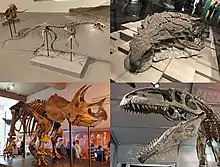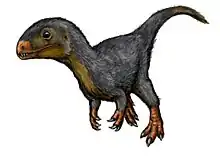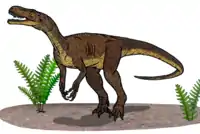Dracohors
Dracohors is a clade of dinosauriform archosaurs that includes dinosaurs and silesaurids.[1] The oldest known dracohortian is Asilisaurus, dating to about 245 million years ago in the Anisian age of the middle Triassic period.[2] According to Andrea Cau (2018), the synapomorphies of dracohortians are:[1]
The anterior tympanic recess, the axial epipophyses, the centrodiapophyseal laminae in the presacral vertebrae, the relative size enlargement of the postacetabular process of ilium, the elongation of the pubis, the proximal sulcus and the reduction of the ligament tuber in the femoral head, and the further reduction in length of the fourth metatarsal and toe compared to the third.
| Dracohors | |
|---|---|
 | |
| From top to bottom and left to right, different type of dracohortians : Asilisaurus, Borealopelta, Triceratops and Giganotosaurus. | |
| Scientific classification | |
| Kingdom: | Animalia |
| Phylum: | Chordata |
| Clade: | Dinosauriformes |
| Clade: | Dracohors Cau, 2018 |
| Subgroups | |
Cau defined the group as the "most inclusive clade containing Megalosaurus bucklandii Mantell, 1827, but excluding Marasuchus lilloensis (Romer, 1971)."[1] A good consensus of phylogenetic work supports the sister grouping of silesaurids and dinosaurs,[2][3][4] but the interrelationships within Dinosauria have been debated. Of particular debate are the positions of various basal Triassic dinosaurs such as Eodromaeus, Daemonosaurus, Pisanosaurus,[5][6][7] and herrerasaurids;[1][8] and the interrelationships of the major dinosaur groups Sauropodomorpha, Theropoda, and Ornithischia.[9] The reason for this uncertainty is the taxon sampling size and the implications of how they affect the coding for the phylogenetic tree.[10]
In his paper about the stepwise evolution of the avian bauplan, Cau (2018) found in the parsimony analysis a polytomy between herrerasaur-grade taxa, Sauropodomorpha and the controversial Ornithoscelida. The Bayesian analysis, however, found weak support for the sister grouping of Dinosauria and Herrerasauria, but strong support for the dichotomy between Sauropodomorpha and Ornithoscelida, as shown below:[1]
| Dracohors |
| ||||||||||||||||||||||||||||||||||||||||||||||||||||||
Etymology
Its name is formed by haplology from Latin draco (dragon, [large] snake) and cohors (cohort (military unit)). Its Latin genitive is dracohortis.[11]
Most names of animal clades are plurals (e.g. Saurischia = "those with hips like those of lizards"), but Dracohors (meaning "the dragon cohort") is the singular of a collective noun.
References
- Andrea Cau (2018). "The assembly of the avian body plan: a 160-million-year long process" (PDF). Bollettino della Società Paleontologica Italiana. 57 (1): 1–25. doi:10.4435/BSPI.2018.01.
- Nesbitt, S.J; Sidor, C.A.; Irmis, R.B.; Angielczyk, K.D.; Smith, R.M.H.; Tsuji, L.M.A. (2010). "Ecologically distinct dinosaurian sister group shows early diversification of Ornithodira". Nature. 464 (7285): 95–98. doi:10.1038/nature08718. PMID 20203608. S2CID 4344048.
- Langer, M.C.; Ezcurra, M.D.; Bittencourt, J.S.; Novas, F.E. (2010). "The origin and early evolution of dinosaurs". Biological Reviews. 85: 55–110. doi:10.1111/j.1469-185X.2009.00094.x. PMID 19895605. S2CID 34530296.
- Kammerer, C. F.; Nesbitt, S. J.; Shubin, N. H. (2012). "The First Silesaurid Dinosauriform from the Late Triassic of Morocco". Acta Palaeontologica Polonica. 57 (2): 277. doi:10.4202/app.2011.0015.
- Agnolín, Federico L.; Rozadilla, Sebastián (2017). "Phylogenetic reassessment of Pisanosaurus mertii Casamiquela, 1967, a basal dinosauriform from the Late Triassic of Argentina". Journal of Systematic Palaeontology. 16 (10): 853–879. doi:10.1080/14772019.2017.1352623. S2CID 90655527.
- Matthew G. Baron; David B. Norman; Paul M. Barrett (2017). "Baron et al. reply". Nature. 551 (7678): E4–E5. doi:10.1038/nature24012. PMID 29094705. S2CID 205260360.
- Matthew G. Baron (2018). "Pisanosaurus mertii and the Triassic ornithischian crisis: could phylogeny offer a solution?". Historical Biology: An International Journal of Paleobiology. 31 (8): 1–15. doi:10.1080/08912963.2017.1410705. S2CID 89924902.
- Matthew G. Baron; Megan E. Williams (2018). "A re-evaluation of the enigmatic dinosauriform Caseosaurus crosbyensis from the Late Triassic of Texas, USA and its implications for early dinosaur evolution". Acta Palaeontologica Polonica. 63. doi:10.4202/app.00372.2017.
- Baron, M.G.; Norman, D.B.; Barrett, P.M. (2017). "A new hypothesis of dinosaur relationships and early dinosaur evolution". Nature. 543 (7646): 501–506. doi:10.1038/nature21700. PMID 28332513. S2CID 205254710.
- Rodrigo Temp Müller; Sérgio Dias-da-Silva (2018). "Taxon sample and character coding deeply impact unstable branches in phylogenetic trees of dinosaurs". Historical Biology: An International Journal of Paleobiology. 31 (8): 1089–1092. doi:10.1080/08912963.2017.1418341. S2CID 90746262.
- Bollettino della Società Paleontologica Italiana, 57 (1), 2018, 1-25. Modena, page 7





